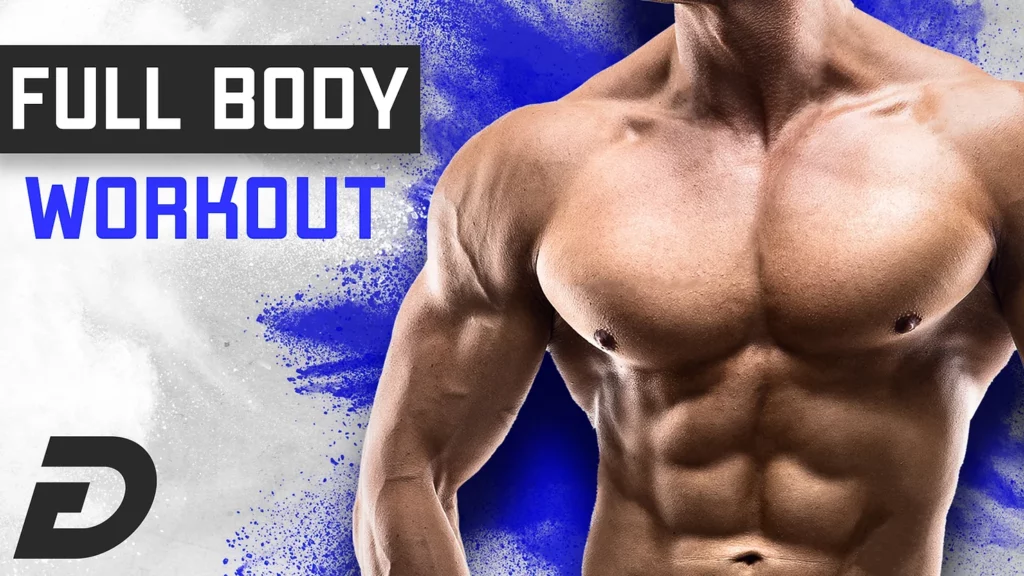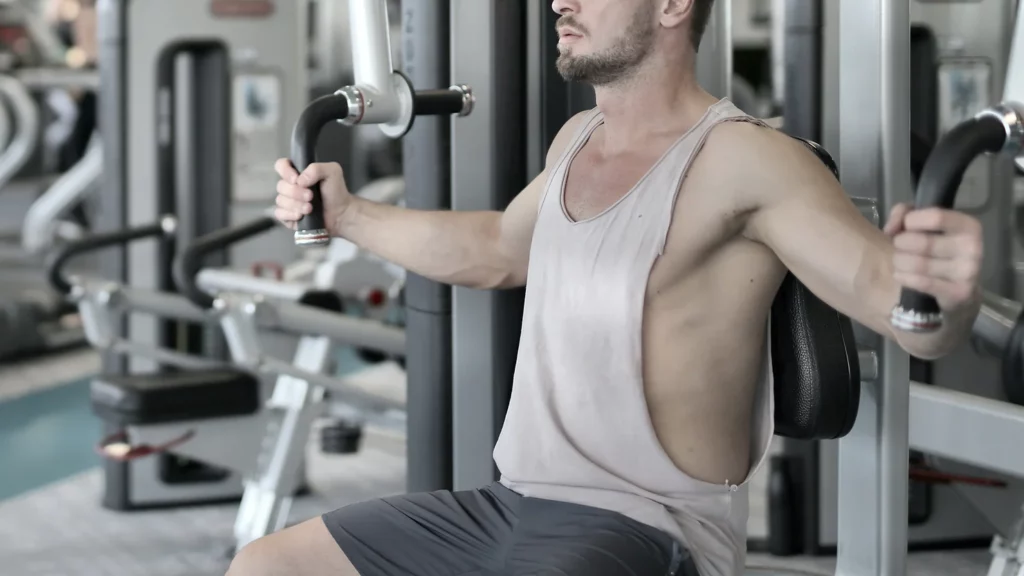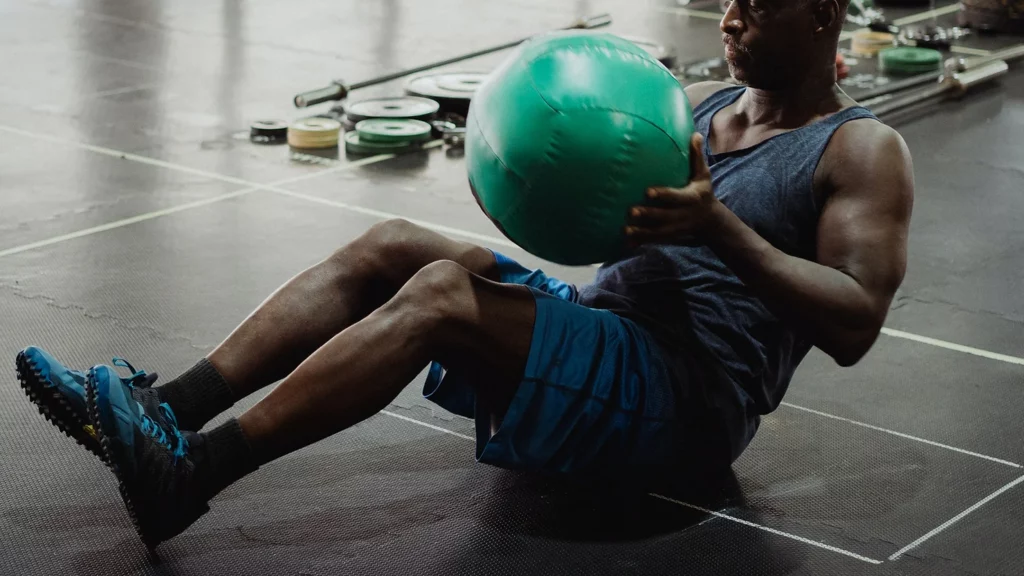Full body workout routines are one of the most effective exercise splits because they can target all the major muscle groups during your training. Focusing on exercises that target multiple muscle groups at once optimally builds muscular strength and size for the entire body.
This method of training allows for efficient recovery between sessions. Having plenty of time for recovery between exercise sessions allows your muscles to grow optimally. Additionally, having ample time for recovery means you can bring 100% of your attention to focus on quality reps and form during exercise.
This article will cover a full-body routine focused on building strength and hypertrophy. We will cover the five exercises essential to building muscle in every major muscle group with accessory exercises for muscles that are typically hard for people to grow. We will also include alternative exercises so that you are not limited to specific movements or if you don’t have access to professional gym equipment. Afterward, we will cover how to prioritize these exercises with examples for you to use or create a variation.
Exercise Split Overview
Ideally, you want to target a muscle group 2-3 times a week. A full-body split allows the muscles to be sufficiently engaged and your muscles enough time to recover between days. A full-body routine is especially beneficial for beginner and intermediate lifters, rather than obsessing over individual body parts and instead focusing on building overall strength and size.
This workout routine will consist of 3 working days: Workout Variation 1-3. Each day of exercise is alternated with a rest day for at least 24-48 hours of recovery.
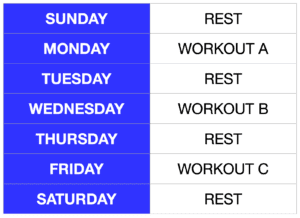
The following sections will cover the best exercises for a full-body workout routine; this includes an exercise description, a visual demonstration with steps, and an alternate exercise list. Following, we will conclude with the complete routine and a full description of the order in which exercises are performed.
Full-Body Workout Routine for Muscle Size
Exercise I: Barbell Bench Press
The barbell bench press is a staple exercise for growing the chest with the added work to the front delts and triceps. Some would consider the flat barbell bench press one of the most effective upper body exercises to add to a fitness routine.
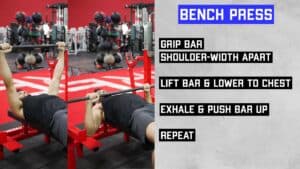
According to this study, the barbell bench press, as compared to dumbbell flys, was much more effective in engaging the pectoralis major, triceps brachii, and deltoid anterior. In addition, as compared to other barbell bench press variations, the flat barbell bench press was the most effective in engaging the chest muscles.
Steps
-
Start with back flat on the bench.
-
Grip the bar slightly outside shoulder-width apart (with the thumb wrapped around the bar). This is so your hands will be directly over your elbows and form a 45° angle with your body.
-
Plant your feet flat on the ground at around a 90° angle and allow your back to slightly arch.
-
Lift bar from the rack, and with control, lower the weight to your chest. During this portion of the exercise, breathe in.
-
While exhaling, push the bar up without locking out your arms.
-
Repeat.
Alternate Exercises
If you find yourself struggling to grow your chest or find the barbell bench press difficult, you can add to or replace it with these exercises:
-
Push-Up (Great for Beginners)*
-
Dumbbell Bench Press (Great for Beginners)*
-
Cable Cross Over
-
Dumbbell Fly
Exercise II: Barbell Overhead Press
The second exercise, the barbell overhead press, is excellent for growing the upper chest, front delts, triceps, and serratus anterior. The overhead press has the added benefit of partially working the side delts, traps, abs, and oblique muscles.
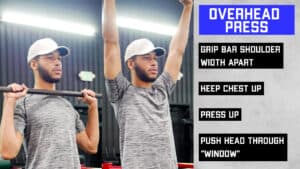
The primary reason for performing this exercise is to build strength and size of the shoulders. According to this study, the overhead press is one of the most effective exercises for engaging the anterior delts. The overhead press can drastically improve the performance of other exercises and the overall aesthetics of the shoulders.
Steps
-
Grip the bar slightly outside shoulder-width apart (with the thumb wrapped around the bar); this is so the elbows stay in line with the hands.
-
Bring your chest up while keeping your ribs down and core engaged. Place the weight on your delts and unrack the barbell.
-
Clench your glutes and maintain a light tension throughout your body. Keep your elbows tucked in by your sides.
-
While tucking your chin (make sure your face is not in the path of the bar), push up and exhale. Avoid fully locking your arms out.
-
Once the bar past your forehead, put your head through the “window” of your arms and untuck your chin.
-
Slowly control the weight back to the start position. As the bar gets close to your head, begin to tuck your chin and bring your head slightly back.
-
Repeat.
Alternate Exercises
If you find yourself struggling to grow your shoulders or find the barbell overhead press difficult, you can add to or replace it with these exercises:
-
Dumbbell Overhead Press (Great for Beginners)*
-
One Arm Shoulder Press (Great for Beginners)*
-
Dumbbell Front Raise (Great for Beginners)*
-
Push Press
Exercise III: Chin-Up
Chin-ups can be one of the best exercises for your back, able to work the entirety of the mid and lower traps, the lats, and the rear delts. Not only is the chin-up a powerful back exercise, but it also functions as a great bicep, forearm, and ab exercise.
Another benefit of the chin-up is that they can be easier than the pull-up because of bicep recruitment. The chin-up can also be loaded significantly to make it a great staple exercise for any routine.
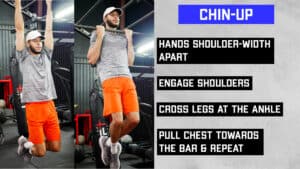
Steps
-
Grab the pull-up bar with an underhand grip at shoulder-width or slightly narrower.
-
Engage your shoulders and make sure your hips are under your body.
-
Cross your legs at the ankle and bend your knees to get into the start position.
-
While keeping your elbows close to your body, pull to bring your chest toward the bar.
-
With control, lower yourself back down to the start position with elbows very slightly bent (avoid locking out your arms).
-
Repeat.
Alternatives
If you find yourself struggling to grow your lats or biceps or find chin-ups difficult, you can add to or replace it with these exercises:
-
Pull-ups
-
Lat pulldowns (Great for Beginners)*
-
Underhand Barbell Rows
-
Dumbbell Rows (Great for Beginners)*
Exercise IV: Barbell Back Squat
The barbell back squat is not only one of the best overall leg exercises but is a great full-body workout. The focus of the barbell back squat is the activation of the quads, glutes, adductors, and calves.
If you want to build significant leg strength and size (especially for the quads) the barbell back squat is a great staple exercise for any routine.
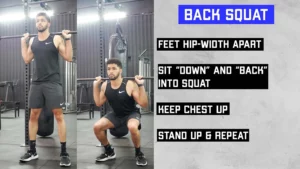
Steps
-
Stand where the racked weight is at the top of the traps.
-
Grab the bar slightly outside shoulder-width and unrack the weight.
-
Take two big steps back and make sure that your feet are roughly shoulder-width apart and toes pointed slightly outward.
-
Allow your knees to bend and sit down and slightly back into movement.
-
Control the weight going down and aim for your knees to be at/or slightly less than 90°. Keep your back straight throughout the movement.
-
Stand up and repeat.
Alternatives
If you find yourself struggling to grow your quads and glutes or find barbell back squat difficult, you can add to or replace it with these exercises:
-
Front Squat
-
Goblet Squat (Great for Beginners)*
-
Leg Press (Great for Beginners)*
-
Low-bar squat
-
Bodyweight Squat (Great for Beginners)*
-
Bulgarian Split Squat
Exercise V: Romanian Deadlift
The Romanian deadlift makes up for where the squats are lacking. Squats are a phenomenal lower body exercise, but they still miss one of the most crucial muscles in the lower body, the hamstrings. When paired with the squat, the Romanian deadlift can target most muscles in the entire body, especially the posterior chain. Although, neither of these exercises targets the anterior portion of the upper body or arms well, hence the need for the first three exercises.
The Romanian deadlift is fantastic for developing the hamstrings, transverse abdominal muscles, lats, and rear delts. This exercise also translates to better posture, injury prevention, and overall leg aesthetic.
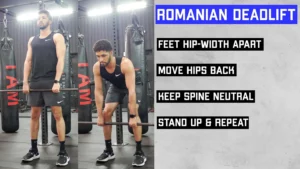
Steps
-
Start with your legs near the bar at about hip-width apart.
-
Grip the bar at shoulder-width or slightly more apart and engage your lats.
-
Lift the bar into position with back straight and global tension (don’t go slack and maintain enough tension to hold your body straight).
-
Controlling the weight downward, hinge at your hips and drive your butt back. Keep your legs and back straight. You can allow some knee bending, but the point of the movement is to load the hamstrings in a stretched position.
-
When you feel your hamstrings fully stretched (not strained or in pain), pull the weight up and return to the standing posture.
-
Repeat.
Alternatives
If you find yourself struggling to grow your hamstrings or find Romanian deadlift difficult, you can add to or replace it with these exercises:
-
Dumbbell Romanian Deadlift (Great for Beginners)*
-
Seated Leg Curl (Great for Beginners)*
-
Lying Hamstring Curl (Great for Beginners)*
-
Goodmorning
-
Deadlift
For more exercises, check out our full-body training program to develop a strong body and aesthetic physique; you will benefit from one of our programs. We designed a program that gives you the tools to build muscle with an easy-to-follow routine that will fit any schedule. To find out more:
Accessory Exercises for Complete Routine
Exercise VI: Barbell Rows
The barbell row is fantastic for any full-body routine because of its ability to target multiple major muscle groups at once. Primarily, this exercise works the lats, traps, and rear delts. This movement can also provide growth secondarily to the biceps, lower back, and forearms. If your goal is to build a wider, fuller, and aesthetic back, this movement is a must for your routine.
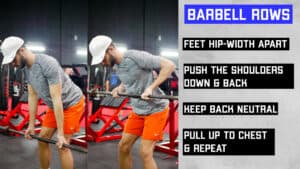
Steps
-
Stand with feet shoulder-width apart. Hinge at the hips so that your body is slightly leaning forward.
-
Grip the bar with a neutral grip with your palms facing towards your body.
-
Focus on depressing the traps. Keep the shoulders relaxed and push them away from your ears.
-
Keep your core engaged and your lower back in a neutral position. Avoid too much arching or rounding in the lower back.
-
Drive the elbows back and focus on engaging the muscles of the back.
-
Lower the weight to the starting position.
-
Repeat.
Alternate Exercises
Here are a few exercises that you can use with barbell rows to target similar muscle groups. These exercises can also replace barbell rows if you do not wish to perform this specific exercise.
-
Dumbbell Row
-
Reverse Fly
-
Dumbbell Deadlift
-
Seated Cable Row
-
Lat Pulldowns
-
Lat Pullovers
Exercise VII: Ab Wheel Rollouts
The core is the foundation for every exercise. Thus, it is crucial to incorporate various movements that prioritize this area. The ab wheel rollout is the perfect exercise to work the different muscles of the core. It effectively targets the rectus abdominis, obliques, and erector spinae. Lastly, it activates the primary muscle group that stabilizes the core, known as the transverse abdominis.
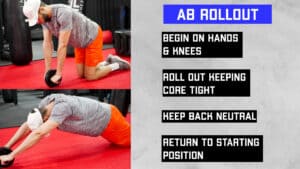
Steps
-
Begin the exercise on your hands and knees.
-
Place your weight on the roller while keeping your knees planted on the ground.
-
Roll out until you reach the farthest point that you can keep your spine neutral or when your body is parallel to the floor.
-
Return to the starting position.
Necessary Cues: It is important to avoid allowing your pelvis to tilt anteriorly during this exercise. You need to try and keep your spine in a neutral position and go slow. If you are unsure how to keep your spine neutral, we recommend you start with a less advanced movement which we will highlight in the next section.
Alternate Exercises
If you want other quality exercises for your core, check out this article. Also, you can add to or replace this workout with these exercises:
-
Planks
-
Plank Walkouts
-
Cable Crunches
-
Hanging Leg Raises
-
V Sit-Ups
Exercise VIII: Calf Raises
The calves are one of the most neglected muscle groups within the body, which is why it is important to target them during your full-body routine. The calves consist of two main muscles: the gastrocnemius and the soleus.
The calf raise is the best isolation exercise to target the calf muscles. They can be performed using a machine in either a standing or a seated position. Calf raises can also be performed using a dumbbell or a barbell if a dedicated calf raise machine is unavailable.
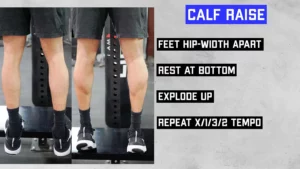
Steps
-
Stand with feet hip-width apart on an elevated platform, or a calf raise machine if you have access.
-
Allow your heels to stretch down without going completely slack at the bottom.
-
Raise your heels and stand up on your toes. You should feel your calves flexing at the top of the movement. Slowly let yourself back down.
-
The best way to perform a calf raise is to go with the tempo X/1/3/2.
-
X/1/3/2: explode up, hold at the top for 1 second, slowly go down for 3 seconds, and hold at the bottom for 2 seconds.
Alternate Exercises
The calf raise is the best movement to target the calves. Although, there are some alternative exercises that you can use to add to or replace this movement.
-
Seated Calf Raise
-
Donkey Calf Raise
-
Toe Walks
-
Jump rope
How to Include These Exercises in a Training Program
How to Prioritize Exercises
For the following workout split example, each workout variation will begin with the main compound movement that you should prioritize. The exercises will be sorted in descending order, with the more intense exercises at the beginning.
The more intense exercises are at the beginning of the workout because they are typically strenuous to perform when fatigued. So, placing the more impactful lifts at the start will allow you to execute higher quality repetitions and overall sets.
Workout Split Examples
The following workouts are two ways to set up a 3-day full-body workout routine. ‘Workout Set B’ is significantly more exhausting and should be completed with less weight and longer rest between sets.
Workout Set A
Workout 1-A
-
Barbell Back Squat (3-5 sets of 8-15 reps)
-
Barbell Bench Press (3-5 sets of 8-15 reps)
-
Chin-Up (3-5 sets of 10-20 reps)
-
Calf Raises (3-5 sets of 10-20 reps)
Workout 2-A
-
Barbell Overhead Press (3-5 sets of 8-15 reps)
-
Barbell Rows (3-5 sets of 8-15 reps)
-
Dumbbell Flys (3-5 sets of 10-20 reps)
-
Ab Wheel Rollouts (3-5 sets of 5-15 reps)
Workout 3-A
-
Romanian Deadlift (3-5 sets of 8-15 reps)
-
Barbell Back Squat (3-5 sets of 8-15 reps)
-
Chin-Up (3-5 sets of 10-20 reps)
-
Calf Raises (3-5 sets of 10-20 reps)
Workout Set B
Workout 1-B
-
Barbell Back Squat (3-5 sets of 8-15 reps)
-
Barbell Bench Press (3-5 sets of 8-15 reps)
-
Chin-Up (3-5 sets of 10-20 reps)
-
Romanian Deadlift (3-5 sets of 8-15 reps)
-
Calf Raises (3-5 sets of 10-20 reps)
Workout 2-B
-
Barbell Overhead Press (3-5 sets of 8-15 reps)
-
Barbell Rows (3-5 sets of 8-15 reps)
-
Dumbbell Flys (3-5 sets of 10-20 reps)
-
Seated Leg Curl (3-5 sets of 10-20 reps)
-
Ab Wheel Rollouts (3-5 sets of 5-15 reps)
Workout 3-B
-
Barbell Back Squat (3-5 sets of 8-15 reps)
-
Barbell Bench Press (3-5 sets of 8-15 reps)
-
Chin-Up (3-5 sets of 10-20 reps)
-
Romanian Deadlift (3-5 sets of 8-15 reps)
-
Calf Raises (3-5 sets of 10-20 reps)
The listed sets and reps are just a guideline. You can develop muscle strength and size in any rep range, but this is a general guide to structure your gym routine.
* Exercises marked (Great for Beginners) are alternatives for those who find the exercises difficult to perform or you do not have access to gym equipment.
Are you looking to get fit? Look no further! Our fitness programs are designed to help you build a strong and aesthetic physique. We also provide easy-to-follow routines that will fit any schedule. With our fitness programs, you'll have the tools you need to build muscle and achieve your fitness goals. Click the link below to get started!

